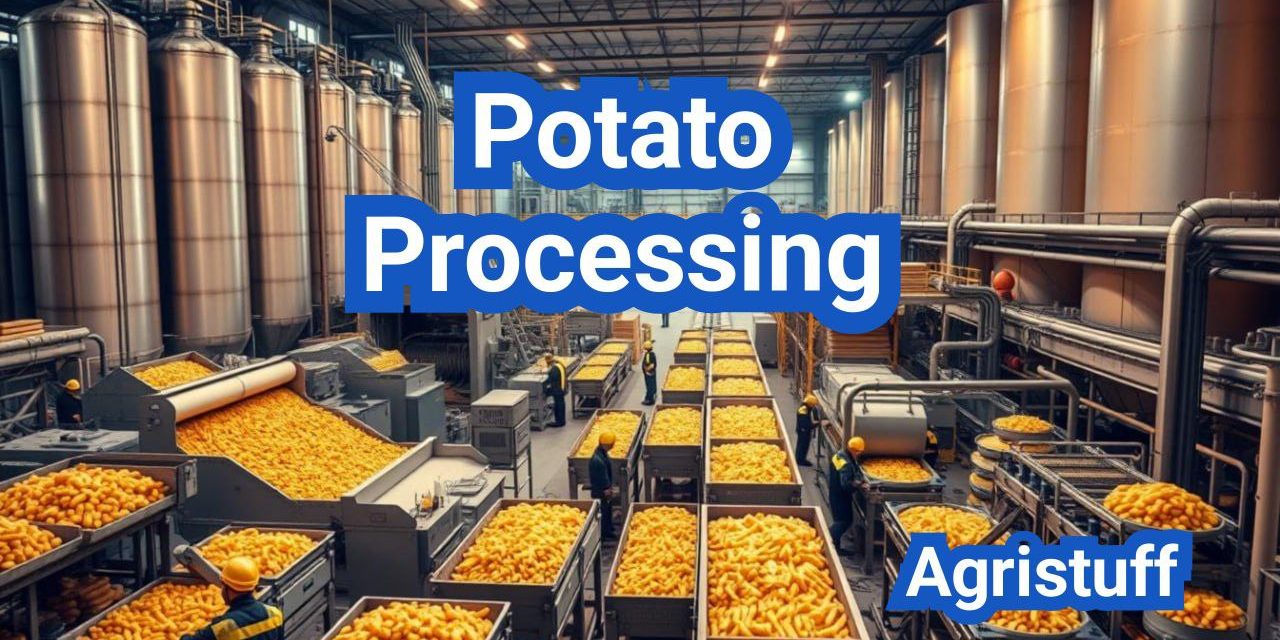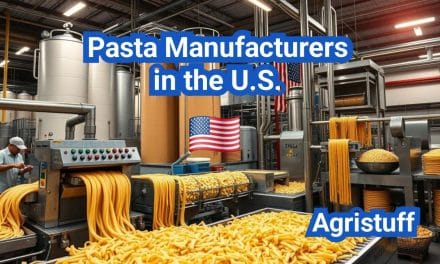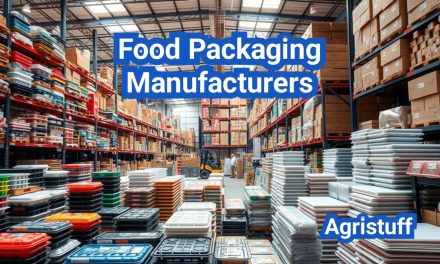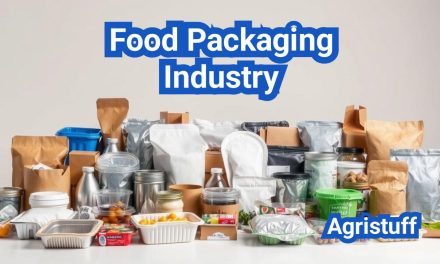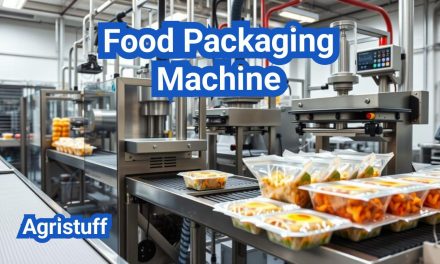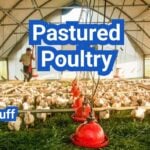The potato processing industry is a significant sector in the United States, producing a wide range of products such as frozen French fries, potato chips, and dehydrated potato flakes. U.S. plants play a crucial role in meeting the demand for these products, both domestically and internationally.
The global market for potato processing was valued at USD 40.97 billion in 2023 and is projected to reach USD 60.08 billion by 2031, indicating a growing demand for processed potato products. Companies involved in this industry are key players in the production of frozen French fries, among other products.
Key Takeaways
- The U.S. is a major player in the global potato processing industry.
- Products such as frozen French fries and potato chips are in high demand.
- The industry is expected to grow significantly by 2031.
- U.S. plants are crucial for meeting both domestic and international demand.
- Various companies are involved in the production processes.
The U.S. Potato Processing Industry Overview
The U.S. potato processing industry is a significant sector with a substantial economic impact. The industry processes a considerable portion of the country’s potato production, with 64.46% of total potato production being utilized for various processed products.
Economic Impact and Market Size
The economic impact of the potato processing industry is multifaceted, contributing significantly to the U.S. economy through job creation, raw material sourcing, and finished product sales. The market size of the industry is substantial, driven by the demand for processed potato products such as frozen French fries, dehydrated potato flakes, and potato chips.
The industry’s market size is influenced by factors such as consumer preferences, production costs, and global trade dynamics. As consumer demand for convenient and processed foods continues to grow, the market size is expected to expand accordingly.
Major Production Regions in the United States
The United States has several major potato production regions that supply the processing industry. These regions include Idaho, Washington, Oregon, and North Dakota, among others. Each region has its unique characteristics in terms of climate, soil quality, and farming practices, which affect potato yield and quality.
The concentration of production in these regions allows for economies of scale in processing and logistics, making the U.S. potato processing industry more competitive globally.
Current Trends and Future Outlook
The U.S. potato processing industry is influenced by various trends, including the growing demand for healthier and more sustainable food options. Processors are responding by innovating their products and production methods to meet these changing consumer preferences.
Looking ahead, the industry is expected to continue evolving, driven by technological advancements, shifting consumer tastes, and global market dynamics. The ability of U.S. potato processors to adapt to these changes will be crucial in maintaining their competitive edge in the global market.
From Farm to Factory: The Potato Supply Chain

Ensuring the quality of processed potato products requires a thorough understanding of the supply chain. The potato supply chain is a multifaceted process that involves several critical steps, from the moment potatoes are harvested on farms to their arrival at processing plants.
Harvesting and Transportation Methods
The harvesting of potatoes is typically done mechanically, using specialized equipment designed to minimize damage to the tubers. Once harvested, potatoes are transported to processing plants, often by truck. The transportation process is critical, as it must be done in a way that prevents damage and maintains the quality of the potatoes.
Efficient harvesting methods are crucial for reducing waste and ensuring that potatoes arrive at the processing plant in good condition. The use of appropriate transportation methods, such as climate-controlled vehicles, can also help in maintaining potato quality during transit.
Storage Requirements for Processing Potatoes
Upon arrival at the processing plant, potatoes are often stored in large quantities before being processed. Proper storage conditions are essential to maintain the quality of the potatoes. This includes maintaining a consistent refrigerated temperature and ensuring good ventilation to prevent moisture buildup.
Storage requirements for processing potatoes include maintaining the right temperature, typically between 40°F and 50°F, and humidity levels to prevent sprouting or rotting. The storage facilities must also be designed to allow for easy inspection and removal of any spoiled potatoes.
Quality Control at Receiving
When potatoes arrive at the processing plant, they undergo a rigorous quality control check. This involves inspecting the potatoes for size, sugar content, and defects. The quality control process is critical in ensuring that only high-quality potatoes are processed into final products.
Potatoes that do not meet the required standards are rejected. The inspection process may include visual checks, as well as more sophisticated testing methods to determine the suitability of the potatoes for processing. Quality control measures are in place to ensure that the final products meet consumer expectations and regulatory standards.
Leading Potato Processing Companies in the USA
The U.S. potato processing industry is led by several key players that have established themselves through their specialties and regional dominance. These companies are crucial in shaping the industry’s landscape, driving innovation, and meeting the growing demand for processed potato products.
Major Industry Players and Their Specialties
Companies like McCain Foods are at the forefront of the U.S. potato processing sector. McCain Foods is known for its wide range of frozen potato products, including French fries and hash browns. Other major players include:
- Lamb Weston: A leading supplier of frozen potato products, known for its innovative processing techniques.
- Simplot: Offers a variety of potato products, including frozen foods, dehydrated potatoes, and potato flakes.
- Ore-Ida: Known for its frozen potato products, including French fries and Tater Tots.
These companies have developed specialties that cater to different market segments, from retail to foodservice.
Regional Processing Hubs
The U.S. potato processing industry is concentrated in regions with favorable climate conditions and access to water. Key regional processing hubs include:
- Idaho: Known for its high-quality potatoes, Idaho is home to numerous processing facilities.
- Washington: Another major potato-producing state with significant processing capacity.
- Oregon: Hosts several processing plants, particularly for frozen potato products.
These regions offer the necessary infrastructure and logistical advantages that support large-scale potato processing operations.
International vs. Domestic Market Focus
While some U.S. potato processing companies focus primarily on the domestic market, others have a significant international presence. Companies like McCain Foods and Lamb Weston export their products to various countries, capitalizing on the global demand for processed potato products.
The international market offers opportunities for growth, but it also presents challenges such as trade regulations and competition from local producers. U.S. companies must navigate these challenges while maintaining their competitive edge through quality, innovation, and efficient supply chain management.
Potato Varieties for Industrial Processing

Different potato varieties are utilized for various industrial processing applications, including French fries, potato chips, and dehydrated products. The choice of potato variety is critical in determining the quality and consistency of the final product.
Russet Varieties for French Fries
Russet Burbank and Russet Norkotah are among the most popular potato varieties used for French fries due to their high starch content, which results in a crispy exterior and fluffy interior. These varieties are preferred for their ability to produce consistent quality fries.
Chip-Specific Potato Varieties
For potato chips, varieties like Atlantic and Snowden are favored due to their high dry matter content and sugar profile, which are crucial for achieving the perfect chip texture and flavor. These chip-specific varieties help in minimizing oil absorption during frying.
Varieties for Dehydrated Products
Potato varieties used for dehydrated products, such as flakes and granules, require high dry matter and specific gravity. Varieties like Russet types are often used because they yield a high-quality dehydrated product with good rehydration properties.
The diversity in potato varieties allows processors to select the most appropriate type for their specific product, ensuring the final product meets consumer expectations in terms of taste, texture, and quality.
Anatomy of a Modern Potato Processing Plant
The anatomy of a modern potato processing plant reveals a complex interplay of various systems and technologies designed to efficiently process potatoes into a variety of products.
Plant Layout and Design Considerations
A well-designed plant layout is crucial for the efficient operation of a potato processing plant. The layout must consider the flow of potatoes through the processing stages, from receiving to packaging.
Key considerations include:
- Optimizing the production line to minimize bottlenecks
- Ensuring adequate storage for raw materials and finished products
- Implementing effective sanitation and cleaning protocols
Water and Energy Management Systems
Water and energy are critical resources in potato processing. Effective management systems are essential for reducing waste and improving efficiency.
| Resource | Management Strategies | Benefits |
|---|---|---|
| Water | Water recycling, efficient cleaning systems | Reduced water consumption, lower wastewater treatment costs |
| Energy | Energy-efficient equipment, optimized heating and cooling systems | Lower energy costs, reduced environmental impact |
Automation and Control Technologies
Automation plays a vital role in modern potato processing plants, enhancing efficiency, consistency, and safety.
Key automation technologies include:
- Automated sorting and inspection systems
- Process control systems for frying and cooking
- Packaging machinery with integrated checkweighers and metal detectors
Cost Factors in Plant Development
The development of a potato processing plant involves significant capital investment. Understanding the cost factors is crucial for budgeting and financial planning.
Major cost factors include:
- Land acquisition and preparation
- Equipment purchase and installation
- Construction and building costs
- Utility connections and infrastructure
Essential Potato Processing Equipment

Efficient potato processing relies heavily on the right equipment, from receiving and storage to cutting and slicing machinery. The quality and efficiency of the production process depend significantly on the type and condition of the equipment used.
Receiving and Storage Equipment
The initial stage of potato processing involves receiving and storing potatoes. Receiving equipment such as scales and graders help in assessing the quality and quantity of the potatoes. Storage facilities are designed to maintain the quality of potatoes by controlling temperature and humidity.
- Scales for weighing incoming potatoes
- Graders for initial quality assessment
- Storage bins or silos with climate control
Cleaning and Peeling Machinery
Before processing, potatoes need to be cleaned and peeled. Cleaning machinery removes dirt and debris, while peeling equipment removes the skin, which is crucial for producing high-quality products.
- Drum washers for thorough cleaning
- Abrasive peelers for efficient skin removal
- Steam peelers for gentle peeling
Cutting and Slicing Equipment
The next step involves cutting or slicing potatoes into the desired shape. Cutting and slicing equipment are designed to produce uniform products, whether it’s French fries, chips, or slices for other products.
- French fry cutters for uniform strips
- Chip slicers for thin, consistent slices
- Dicers for cubed potatoes
Sorting and Inspection Systems
After cutting, potatoes are sorted and inspected for quality. Sorting and inspection systems use advanced technologies like optical sorters to remove defective products, ensuring that only high-quality products reach the consumer.
“Advanced sorting technologies have revolutionized the potato processing industry by significantly improving product quality and reducing waste.” – Industry Expert
By utilizing the right equipment at each stage, potato processing plants can optimize their operations, improve product quality, and meet consumer demands efficiently.
Step-by-Step Potato Processing Techniques

Potato processing involves several critical steps, from preparation to final treatment, to produce high-quality products. Understanding these steps is essential for manufacturers to ensure the production of consistent and high-quality potato products.
Initial Preparation Steps
The initial preparation of potatoes is crucial for the quality of the final product. This step typically involves receiving and storing potatoes, followed by cleaning to remove dirt, debris, and any foreign materials. Effective cleaning ensures that the potatoes are free from contaminants that could affect the taste, texture, and safety of the final product.
Peeling and Trimming Methods
Peeling is a significant step in potato processing, with various methods employed depending on the desired product. Common peeling methods include mechanical peeling, steam peeling, and chemical peeling. Each method has its advantages and is chosen based on the type of potato and the final product requirements. Trimming follows peeling to remove any blemishes or defects, ensuring that only the best quality potatoes are processed further.
Cutting and Size Reduction
After peeling and trimming, potatoes are cut into the desired shapes and sizes. This step is critical for products like French fries, where uniform cutting is necessary for consistent frying. Various cutting techniques are used, including slicing, dicing, and strip cutting, depending on the intended product.
Blanching and Pre-Treatment
Blanching is a pre-treatment step that involves briefly submerging the cut potatoes in hot water or steam. This process inactivates enzymes that could cause spoilage and improves the texture of the potatoes. Blanching is followed by other pre-treatments, such as drying or pre-frying, to prepare the potatoes for the final processing steps.
French Fry Production Process in Detail

French fry manufacturing is a sophisticated process that combines traditional techniques with modern technology to achieve consistent results. The production of high-quality French fries involves several key steps, from pre-processing to packaging.
Pre-Processing Requirements
Before potatoes are processed into French fries, they must meet specific criteria. The selection of potato varieties is crucial, as different varieties have distinct characteristics that affect the final product’s quality. Russet Burbank and Shepody are popular choices for French fry production due to their high starch content and desirable texture.
According to industry experts, “The right potato variety can make all the difference in the quality of the final product.”
“Potato variety selection is a critical step in French fry production, as it directly impacts the yield, texture, and flavor of the fries.”
Cutting and Blanching Techniques
The cutting process is a critical step in French fry production. Potatoes are cut into long, thin strips, typically using rotary cutters or blade cutters. The cutting technique used can significantly impact the final product’s texture and appearance.
Blanching is another essential step, as it removes excess starch and helps achieve the desired color and texture. The blanching process typically involves immersing the cut potatoes in hot water or steam.
Par-Frying and IQF Freezing Methods
After blanching, the French fries are par-fried in hot oil to partially cook them. This step is crucial for achieving the right texture and flavor. The par-frying temperature and time are carefully controlled to ensure consistency.
The par-fried French fries are then frozen using IQF (Individual Quick Freezing) technology. IQF freezing ensures that the fries are frozen individually, preventing them from sticking together. This method helps preserve the texture and quality of the French fries.
Packaging Systems for Frozen Fries
The final step in French fry production is packaging. Frozen French fries are typically packaged in airtight bags or containers to prevent freezer burn and maintain quality. The packaging material is chosen for its ability to withstand freezing temperatures and prevent moisture from entering the package.
In conclusion, the production of French fries involves a complex series of steps, from pre-processing to packaging. By understanding these steps, manufacturers can produce high-quality French fries that meet consumer expectations.
Potato Chip Manufacturing Process

Potato chip manufacturing involves a series of complex processes, from preparation to packaging. This intricate process requires careful attention to detail to produce high-quality potato chips that meet consumer expectations.
Slice Preparation and Washing
The first step in potato chip manufacturing is slice preparation. Potatoes are washed, peeled, and sliced into very thin rounds. These slices are then washed to remove excess starch, which helps improve the texture of the final product.
Advanced slicing technologies are used to ensure uniformity in slice thickness, which is crucial for even frying. The washing process not only removes starch but also helps in removing any impurities or debris from the slices.
Frying Technology and Oil Management
Frying is a critical step in potato chip manufacturing. Advanced frying technologies are employed to achieve the perfect crispiness. The frying process involves immersing the potato slices in hot oil, typically between 150°C to 180°C, for a specific duration.
Effective oil management is essential to maintain the quality of the potato chips. This includes monitoring oil temperature, filtering out debris, and replenishing oil as necessary to prevent degradation.
Flavoring Application Systems
After frying, potato chips are seasoned with various flavors to enhance their taste. Flavoring application systems are designed to distribute seasonings evenly across the chips. These systems can handle a wide range of flavors, from simple salt to complex spice blends.
Packaging Innovations for Extended Shelf Life
The final step in potato chip manufacturing is packaging. Innovative packaging solutions are used to maintain the freshness and crispiness of the potato chips. Packaging materials that are barrier-resistant to moisture and oxygen are preferred to extend shelf life.
Additionally, packaging designs that minimize exposure to air, such as resealable bags or nitrogen flushing, are employed to keep potato chips fresh for a longer period.
Dehydrated Potato Flakes and Granules Production

Dehydrated potato products, such as flakes and granules, are manufactured through a series of precise industrial processes. These products are essential ingredients in various food applications, including instant soups, snacks, and ready-to-eat meals.
Cooking and Mashing Procedures
The production of dehydrated potato flakes begins with cooking and mashing potatoes. The potatoes are first washed, peeled, and then cooked until they are tender. After cooking, they are mashed to create a uniform consistency. This step is crucial as it affects the final texture of the dehydrated product.
Cooking parameters, such as temperature and time, are carefully controlled to ensure that the potatoes are cooked evenly. The mashing process involves breaking down the cooked potatoes into a smooth, consistent mash.
Drum Drying Technology
Drum drying is a critical step in the production of dehydrated potato flakes. The mashed potatoes are spread onto the surface of a heated drum, where the water content is rapidly reduced, resulting in a dry flake. This process requires precise control over drum temperature and rotation speed to achieve the desired dryness and flake quality.
The use of drum drying technology allows for efficient and high-volume production of dehydrated potato flakes. The flakes are then collected and processed further for packaging.
Granulation and Sizing Methods
For dehydrated potato granules, the process involves an additional step of granulation after drying. The dried potato material is granulated into uniform particles. Sizing methods are employed to ensure that the granules meet the required specifications for various applications.
Granulation techniques can vary depending on the desired final product characteristics, such as particle size and flowability. Advanced sieving and milling technologies are used to achieve the desired granule size and consistency.
Quality Control in Dehydrated Products
Quality control is paramount in the production of dehydrated potato flakes and granules. The final products are subject to rigorous testing for moisture content, texture, and microbial safety. Ensuring that the products meet the required standards is crucial for their use in food manufacturing.
Manufacturers implement strict quality control measures throughout the production process, from raw material sourcing to final packaging, to guarantee the quality and safety of dehydrated potato products.
Food Safety Protocols in Potato Processing

Food safety protocols play a crucial role in the potato processing industry, safeguarding consumer health and product quality. These protocols are designed to prevent contamination and ensure compliance with regulatory standards.
FSMA Compliance Requirements
The Food Safety Modernization Act (FSMA) sets forth regulations that potato processing facilities must follow. This includes implementing preventive controls, conducting regular inspections, and maintaining detailed records to ensure compliance.
Facilities must also undergo regular audits to verify their compliance with FSMA regulations. This involves reviewing their food safety plans and ensuring that all personnel are trained in food safety practices.
Acrylamide Reduction Strategies
Acrylamide is a potential carcinogen that can form in potato products during high-temperature processing. To mitigate this risk, processors employ strategies such as adjusting cooking times and temperatures, and using ingredients that help reduce acrylamide formation.
Microbial Control Points
Controlling microbial growth is critical in potato processing. This involves identifying critical control points in the production process where microbial contamination can occur. Measures to prevent contamination include proper cleaning and sanitizing of equipment.
Allergen Management Programs
Potato processing facilities must also manage allergens to prevent cross-contamination. This includes implementing segregation protocols for different products and conducting regular allergen testing. Staff training on allergen awareness is also crucial.
By implementing these food safety protocols, potato processing facilities can ensure the production of safe, high-quality products that meet regulatory requirements and consumer expectations.
Sustainable Practices in U.S. Potato Processing Plants

U.S. potato processors are adopting sustainable practices to minimize their ecological footprint. This shift is driven by both environmental concerns and the need to improve operational efficiency.
Water Conservation Techniques
Water conservation is a critical aspect of sustainability in potato processing. Plants are implementing advanced water recycling systems and optimizing cleaning processes to reduce water usage. For instance, some facilities are using closed-loop systems that allow for the reuse of water in various stages of processing.
Waste Stream Valorization
Waste stream valorization involves converting waste materials into valuable products. In potato processing, this can include using peels and other by-products for animal feed or bioenergy production. Some companies are also exploring the use of potato waste for biogas generation, providing an additional revenue stream.
Energy Efficiency Measures
Energy efficiency is another key area of focus. Potato processing plants are adopting energy-efficient technologies such as cogeneration systems and advanced lighting solutions to reduce their energy consumption. Additionally, some facilities are optimizing their production schedules to minimize peak energy demand.
Packaging Sustainability Initiatives
Packaging sustainability is becoming increasingly important. Companies are exploring biodegradable packaging options and reducing packaging material usage through design innovations. Some are also implementing recycling programs for packaging waste, further reducing their environmental impact.
By adopting these sustainable practices, U.S. potato processing plants are not only reducing their environmental footprint but also improving their operational efficiency and product quality.
The Future of Potato Processing in America
The potato processing industry in the United States is poised for continued growth, driven by increasing demand for processed potato products. As consumer preferences evolve, manufacturers are adapting to trends such as the demand for healthier, more sustainable products.
The future of potato processing will be shaped by technological advancements, including improvements in automation, water conservation, and waste reduction. Companies like Lamb Weston and Simplot are already investing in innovative technologies to enhance efficiency and reduce environmental impact.
As the global potato-processing market continues to expand, U.S. producers are well-positioned to capitalize on emerging opportunities. By understanding potato processing industry trends and staying ahead of the curve, manufacturers can drive growth and success in this dynamic market.
FAQ
What is the significance of the potato processing industry in the United States?
The potato processing industry is a significant sector in the United States, producing a wide range of products such as frozen French fries, potato chips, and dehydrated potato flakes, meeting both domestic and international demand.
What are the major production regions for potatoes in the United States?
Major production regions for potatoes in the United States include various states with suitable climate and soil conditions for potato cultivation, contributing to the country’s potato supply.
How do potato processing companies ensure the quality of their products?
Potato processing companies ensure quality through various measures, including quality control at receiving, proper storage requirements, and adherence to food safety protocols such as FSMA compliance.
What are the different types of potato varieties used for industrial processing?
Different potato varieties are used for various processing applications, including Russet varieties for French fries, chip-specific varieties for potato chips, and other varieties for dehydrated products.
How do modern potato processing plants manage water and energy?
Modern potato processing plants implement water and energy management systems to optimize resource utilization, reduce waste, and promote sustainability.
What are the key steps involved in potato processing techniques?
Key steps in potato processing include initial preparation, peeling and trimming, cutting and size reduction, blanching, and pre-treatment, each playing a critical role in producing high-quality products.
How is French fry production carried out in U.S. plants?
French fry production involves pre-processing requirements, cutting and blanching techniques, par-frying, and IQF freezing methods, followed by packaging systems for frozen fries.
What is the process for manufacturing potato chips?
Potato chip manufacturing involves slice preparation and washing, frying technology and oil management, flavoring application systems, and packaging innovations for extended shelf life.
How are dehydrated potato flakes and granules produced?
Dehydrated potato flakes and granules are produced through cooking and mashing procedures, drum drying technology, granulation and sizing methods, and quality control measures.
What food safety protocols are in place in potato processing plants?
Potato processing plants adhere to food safety protocols, including FSMA compliance, acrylamide reduction strategies, microbial control points, and allergen management programs.
What sustainable practices are being adopted in U.S. potato processing plants?
U.S. potato processing plants are adopting sustainable practices, including water conservation techniques, waste stream valorization, energy efficiency measures, and packaging sustainability initiatives.
Conclusion of: Potato Processing In USA
Introduction: why potato processing matters in the U.S.
Potato processing underpins how Americans actually eat potatoes: most pounds show up as frozen fries, chips, or dehydrated ingredients that flow through restaurants, groceries, and foodservice. In 2024, frozen potato products were the largest share of U.S. potato availability by weight, ahead of fresh table stock and chips, which explains why potato processing is central to throughput, pricing, and consumer choice. This guide walks you through how U.S. facilities turn raw tubers into consistent fries, flakes, and chips—step by step—with practical notes on food safety, quality, acrylamide mitigation, oil management, and environmental compliance. USDA ERS: Vegetables & Pulses Outlook (2025)
The big picture: what potato processing plants make
In potato processing, U.S. plants focus on three high-volume categories: quick-frozen French fries (par-fried, then IQF and packed), potato chips (thin slices fried and nitrogen-flushed), and dehydrated forms such as flakes (drum-dried mash for instant mashed potato and as a functional ingredient). Each format has its own specifications—dimensions, moisture, oil content, and defect tolerances—that guide line design and QA. Codex Standard: Quick Frozen French Fried Potatoes
Raw material selection: varieties that love potato processing
The foundation of reliable potato processing is cultivar choice with good specific gravity, shape, and storage performance. Classic and emerging U.S. processing varieties include Russet Burbank, Ranger Russet, Umatilla Russet, and Clearwater Russet—selected for fry color, solids, and resistance to cold-induced sweetening that can darken products and raise acrylamide potential. Variety choice sets expectations for cutting yield, oil uptake, and texture across every potato processing line. Potato Association of America: Commercial Potato Production in North America
Receiving and storage: setting up potato processing for success
After harvest, processors receiving for potato processing typically cure tubers and manage storage at controlled temperature and humidity to minimize bruising and cold-induced sweetening. University of Idaho storage work illustrates common practice: cure around 55°F with high RH, then pull down gradually to long-term set points (often in the 42–48°F range depending on variety and end use) before grading and delivery to the line. Tight storage control preserves fry color and chip quality in downstream potato processing. Univ. of Idaho: Storage Management of Potatoes
Primary prep: washing, peeling, and trimming for potato processing
Potato processing lines start with washing and peeling to remove soil and skin, followed by trimming and optical inspection to knock out defects that would show up as dark spots or slivers. Dehydrated products explicitly require clean, sound potatoes and often steam-peeling before cooking and mashing; clear definitions and defect thresholds are codified in federal purchase specs for dehydrated potatoes used widely in U.S. commerce. This early discipline reduces waste and improves downstream yield in potato processing. USDA AMS: A-A-20032H Dehydrated Potatoes (CID)
Cutting and sorting: getting the right geometry in potato processing
For fries, potato processing centers on cut size and uniformity—shoestring, medium, thick, or extra-large—because cross-section controls moisture loss, oil uptake, texture, and cook time. Quality systems track “slivers,” “small pieces,” and “scrap,” with tolerances to protect appearance and yield. Aligning knives and optical sorters to these targets stabilizes your line and reduces rework in potato processing. Codex: Style & Defect Tolerances for Frozen Fries
Blanching for fries: color, texture, and sugars in potato processing
Blanching is standard in fry-focused potato processing: it leaches surface sugars, sets texture, and pre-conditions strips for even color after par-fry and finish. It also assists acrylamide control for French fries by reducing reducing-sugar/asparagine interactions before high-temperature steps. Processors tune time/temperature and adders (e.g., pyrophosphate or dextrose where permitted) to strike the color/texture balance in potato processing. FDA Guidance: Acrylamide in Foods (industry mitigation)
Par-frying & oil management: the heart of fry potato processing
In par-fry operations, potato processing aims for a controlled crust and target solids while keeping oil quality within spec. International standards cap free fatty acids in the extracted oil from frozen fries, and plants manage turnover, filtration, and temperature to avoid off-flavors and oxidation. The par-fried product is then ready for rapid freezing and distribution in potato processing. Codex: Analytical Limits (FFA) for Frozen Fries
IQF freezing and packing: locking in quality in potato processing
After par-frying and cooling, potato processing pushes strips through spiral or tunnel freezers to pass quickly through the maximum crystallization zone and reach −18°C (0°F) at the thermal center. Individual Quick Freezing (IQF) preserves piece separation, reduces clumping and breakage, and sets up consistent oven or fryer performance for foodservice. Packout then protects the product from dehydration and contamination during the rest of the potato processing cold chain. Codex: Quick Freezing & Packaging Provisions
Chip lines 101: slicing, frying, and MAP in potato processing
Potato chip processing is lean and fast: slice uniformly, rinse to remove free starch, fry to a defined moisture, season, and protect with barrier packaging. Modern potato processing relies on modified-atmosphere packs (nitrogen flush) to curb oxidation and breakage so chips hold texture and flavor on shelf without added preservatives. Good air removal and headspace control are as critical as oil management in chip potato processing. NCBI/PMC: Modified-Atmosphere Packaging Overview
Acrylamide mitigation: practical controls in potato processing
Acrylamide forms in high-temperature cooking of potatoes; mitigation is now embedded in potato processing programs. FDA’s guidance highlights raw material selection (varieties and storage that avoid cold-sweetening), sugar/asparagine control, color targets, and time-temperature optimization. For chips specifically, FDA notes blanching is generally not desirable because it can increase oil uptake; for fries, blanching is commonly used for both color and mitigation. Keeping these controls documented in your food safety plan is standard practice in potato processing. FDA: Acrylamide Mitigation Guidance
Dehydrated flakes: drum-drying science in potato processing
Flakes are made by cooking and mashing potatoes, drum-drying a thin sheet, and breaking it into pieces—an efficient potato processing route that creates rapid-rehydrating particles for mashed potato, bakery, and snack applications. U.S. specs cap moisture (≤9% for flakes), set microbiological limits, and allow certain optional ingredients (e.g., sulfiting agents with specific ppm caps) to protect color. These documents anchor QA and supplier approval in dehydrated potato processing. USDA AMS: Dehydrated Potatoes (CID) & Limits
Government purchase standards: aligning QA in potato processing
Beyond general specs, detailed commodity requirements spell out appearance, defect tolerances, analytical tests, and packaging for government purchases of dehydrated potatoes—useful benchmarks even for commercial plants. Moisture for flakes is typically limited to ≤9.0%, sulfites to ≤500 ppm (as SO₂), and reducing sugars to ≤4.0%, with defined defect counts per sample—clear, auditable targets for potato processing teams. USDA AMS: Commodity Spec—Dehydrated Potato Products
Regulatory basics: FSMA-ready potato processing
U.S. potato processing facilities covered by FDA must meet 21 CFR Part 117—CGMPs plus a hazard analysis and risk-based preventive controls program (PCHF), including supply-chain controls, monitoring, verification, and a recall plan. The rule codifies expectations for sanitary design, personnel hygiene, allergen control (for coated fries or flavored chips), and foreign-material prevention—cornerstones of any modern potato processing operation. 21 CFR Part 117: CGMP & Preventive Controls
Environmental compliance: managing water & waste in potato processing
Potato processing generates peel, starch fines, and high-COD wastewater from washing, blanching, and cutting steps. EPA’s effluent guidelines (40 CFR Part 407) cover frozen and dehydrated potato subcategories and tie into discharge permitting; processors reduce loadings with peel recovery, starch capture, and anaerobic pretreatment. Understanding your subcategory and permit limits is part of responsible potato processing. EPA: Fruits & Vegetables Effluent Guidelines
Specifications for fries: dimensions, defects, and color in potato processing
Fry programs specify cross-section (e.g., 8–12 mm “medium”), moisture limits, and tolerances for slivers, small pieces, and burnt bits; many plants align with public standards so suppliers and customers speak the same language. Using recognized criteria streamlines lot acceptance and helps correlate lab results to fryer performance in potato processing. Codex: Quick-Frozen French Fries—Specs & Sampling
Market context: where potato processing products go
U.S. trade and consumption patterns reinforce the weight of potato processing: frozen potato products dominate domestic availability, and frozen fries lead both import and export volumes among processed vegetables. These trends inform capacity decisions, contract farming, and packaging formats across the potato processing sector. USDA ERS: 2024–2025 Potato Availability & Trade
Emerging tech: line tweaks that help potato processing
Processors continue to trial innovations like pulsed electric field (PEF) treatment ahead of cutting to reduce breakage and oil uptake, advanced optical sorting to remove sugar-ends, and tighter fryer analytics. While not mandatory, these upgrades can stabilize texture and color at scale and are increasingly visible on modern potato processing lines. IFT: Pulsed Electric Field in Processing
Final thought
The throughline in potato processing is control: pick the right variety, manage storage and sugars, standardize cuts, control oil and moisture, and document mitigation in a FSMA-compliant plan. Do those consistently—and align to published specs—and potato processing will deliver fries, flakes, and chips that meet U.S. market expectations batch after batch. FDA: FSMA Preventive Controls Rule
Sources & References
- USDA ERS — Vegetables and Pulses Outlook: April 2025 (potato availability, trade)
- Codex Standard for Quick Frozen French Fried Potatoes (CXS 114-1981)
- FDA Guidance for Industry: Acrylamide in Foods
- 21 CFR Part 117 — CGMP & Preventive Controls for Human Food
- USDA AMS — A-A-20032H: Potatoes, White, Dehydrated (CID)
- USDA AMS — Commodity Specification: Dehydrated Potato Products (2021)
- University of Idaho — Storage Management of Potatoes
- Potato Association of America — Commercial Potato Production in North America
- EPA — Effluent Guidelines: Canned & Preserved Fruits and Vegetables (40 CFR Part 407)
- NCBI/PMC — Modified Atmosphere Packaging overview (principles applied to snacks)

